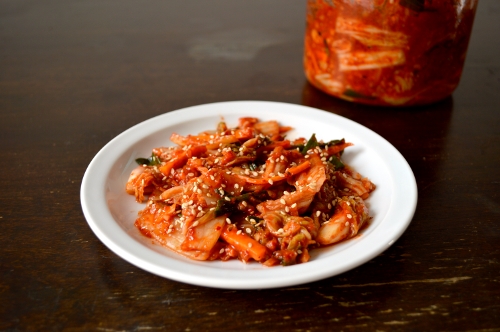
One of my best friends in middle school was Korean, and I remember fondly much of our time spent together after school. We would take the school bus to her house, and there was always perfectly cooked rice waiting in the rice cooker, sheets of seaweed to wrap it in, and delicious homemade kimchi. At the time, I wasn’t even a fan of standard pickles, and kimchi, with its fermented odor and strangely bright red, nearly unrecognizable vegetables, seemed quite intimidating when my friend first offered it to me. But I knew it was rude to refuse, so I tried it. And somehow I was quickly taken in by the bold flavors, a mix of sour, spicy, and even a little sweet that made plain rice into a treat.
I’ve eaten a lot of kimchi since then, and these days, it’s hard for me to resist, whether it’s a side to Korean barbecue, flavoring ramen, or in an omelet. I tried my hand at making my own before, but the flavor wasn’t quite right. Now that I’m in Buenos Aires, where there seems to be a dearth of good Asian food (and certainly a dearth of spicy food), I figured it was worth another shot. I compared several recipes and techniques and tried to keep things simple but authentic with my take. The only specialty ingredients here are the Korean red chili pepper flakes (gochugaru) (which I actually carted along with me from the U.S.) and fish sauce; both shouldn’t be hard to find in an Asian market (and the gochugaru can be replaced, if necessary). As I was chopping the cabbage (feeling pleasantly surprised at having been able to find Napa cabbage at my neighborhood verduleria), I started to worry that this would make too much kimchi. And even after it reduced dramatically from the initial salting, I was still concerned. But as I packed the ready-to-ferment kimchi into its large jar, I tasted a piece, and suddenly I wondered if maybe I hadn’t made enough. The fermentation only adds more complexity and the characteristic tang to the kimchi (oh, and some great health benefits, too), and I can easily say now that I’m quite happy with this recipe. I’ve been snacking on it plain, drizzled with a little sesame oil and sprinkled with sesame seeds, and loving it.
Homemade Kimchi (adapted from Mummy, I Can Cook)
Yield: about 6 cups
Ingredients:
- 1 head Napa cabbage, roughly chopped
- 1/2 cup kosher salt
- 1/2 cup Korean red chili pepper flakes (gochugaru)*
- 1/4 cup fish sauce
- 1 onion, minced
- 1 pear, grated
- 6 – 8 cloves garlic, minced
- 1″ piece fresh ginger, minced
- 1 – 2 carrots, julienned
- 4 – 6 scallions, green parts, sliced into 1″ pieces
*These are brilliantly red yet on the mild side – I recommend trying your best to find them. You may be able to use other red pepper flakes or ground chiles, but make sure to adjust the amount as 1/2 cup of gochugaru (even though it’s mild) results in a quite spicy kimchi, so you’ll want to use decrease the amount if you’re using something spicier.
Method:
- Soak 1 head napa cabbage, roughly chopped in cold water for 5 – 10 minutes, then drain.
- Sprinkle the cabbage evenly with 1/2 cup kosher salt. Let sit for 1 1/2 hours, turning the pieces every half hour; the cabbage should release liquid and reduce dramatically in size.
- Meanwhile, in a small bowl, combine 1/2 cup Korean red chili pepper flakes (gochugaru), 1/4 cup fish sauce, 1 onion, minced, 1 pear, grated, 6 – 8 cloves garlic, minced, and 1″ piece fresh ginger, minced, and stir together to form a paste.
- Drain any accumulated liquid from the cabbage, and rinse the cabbage very thoroughly, squeezing to get out any excess liquid.
- In a large bowl, combine the drained and rinsed cabbage with the spicy paste, 1 – 2 carrots, julienned, and 4 – 6 scallions, green parts, sliced into 1″ pieces. Mix well, making sure the cabbage pieces are all coated with the spicy paste.
- Transfer to a jar, making sure to leave at least an inch of headspace at the top (since the kimchi will bubble and expand as it ferments), and seal tightly with the lid. Let sit at room temperature until the kimchi has been fermenting and has a sour kick to the taste, about 1 – 2 days. The kimchi will release liquid, bubble, and smell sour – these are all signs of the fermentation process.
- Move the jar to the refrigerator – the kimchi will continue fermenting slowly, but is ready to eat now. Make sure to press the kimchi under its juices every time you take some out. Serve (drizzled with a little sesame oil and a sprinkle of sesame seeds, if desired) as a side to meat or fish, on top of rice, or mixed into soups and stews.

3 thoughts on “Homemade Kimchi”